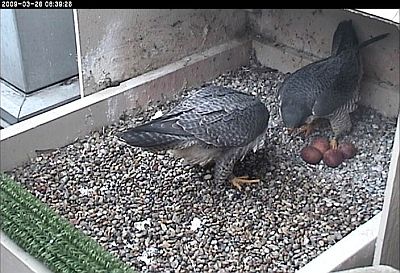
This morning there are four eggs at the University of Pittsburgh peregrine nest. Many of you saw the eggs when Dorothy got up at about 8:15am. E2 arrived almost immediately so it was a very brief glimpse.
Then at 8:30am Dorothy came back and the two of them bowed over their eggs before she sat down again.
This is likely to be her complete clutch – but you never know.
(photo from the National Aviary webcam at Univ. of Pittsburgh)
Dorothy has nested since 2002 at Pitt. She is still producing eggs and its 2009. Will there come a time when she is no longer laying eggs?
I believe Dorothy will lay eggs here for the rest of her life … because she will be replaced by a younger female if she becomes unproductive.
The older a female peregrine gets, the more likely she will lay fewer eggs. In the 1980s and 1990s when adult peregrines were still scarce in the eastern U.S., older female peregrines could maintain territory even when they laid fewer eggs per season. Then after a year or two they were replaced by younger females. Nowadays there are enough peregrines vying for territory that an unfit male or female would soon be replaced at a prime site like the University of Pittsburgh.
Yay mama birdies! Let’s hope all the eggs will hatch.
Hasn’t Tasha nested at the Gulf Tower site since 1998? Or was that Tasha 1 with Boris previously? And this is another Tasha (2)? I am not following along? How long do the females reproduce? Their entire lifespan?
In this past hour I have become an auntie to the eggs, and so luckily grateful to have landed on your blog — while I was searching for someone else to convince me that I long to live at — or in — a lake, to commune with the birds.
I searched on something like “long for birds outside my window” and voila.
Your blog and the links I followed have veered me towards that resolution, and have you and your passion to thank.
Now I will be following the cams and blogs, and I’ll be following your postings with glee.
Hooray for spring! Thank you!
Tasha is “Tasha 2.” (Sorry. I was abbreviating.)
Tasha 2 has nested at Gulf Tower since 1998 when she arrived unbanded. She was Boris’ second mate. His first mate who nested with him at Gulf Tower 1991-1997 was nicknamed “Natasha.”
Tasha 2 was banded that first year when her chicks were banded so biologists could identify her and know she’s the same bird year after year.
The oldest peregrines in the wild live 16-20 years and the females appear to be fertile that whole time, though the number of eggs they lay tends to drop off. I may have been too oblique when I said that “an unfit male or female would soon be replaced at a prime site.” What I mean is that young peregrines looking for a nesting site will fight older ones to win the site and they will kill the resident if the resident isn’t strong enough. See this Peregrine FAQ for more information:
http://www.birdsoutsidemywindow.org/peregrine-faqs/question-fidelity-to-their-mates-and-fighting/
This is such a cool picture with both the adults and the four eggs!!! As of Friday the Wilmington falcons had two eggs! I wonder if you guys always have eggs before us. I would think it would be the other way around. We’ll have to compare notes one of these days. 🙂